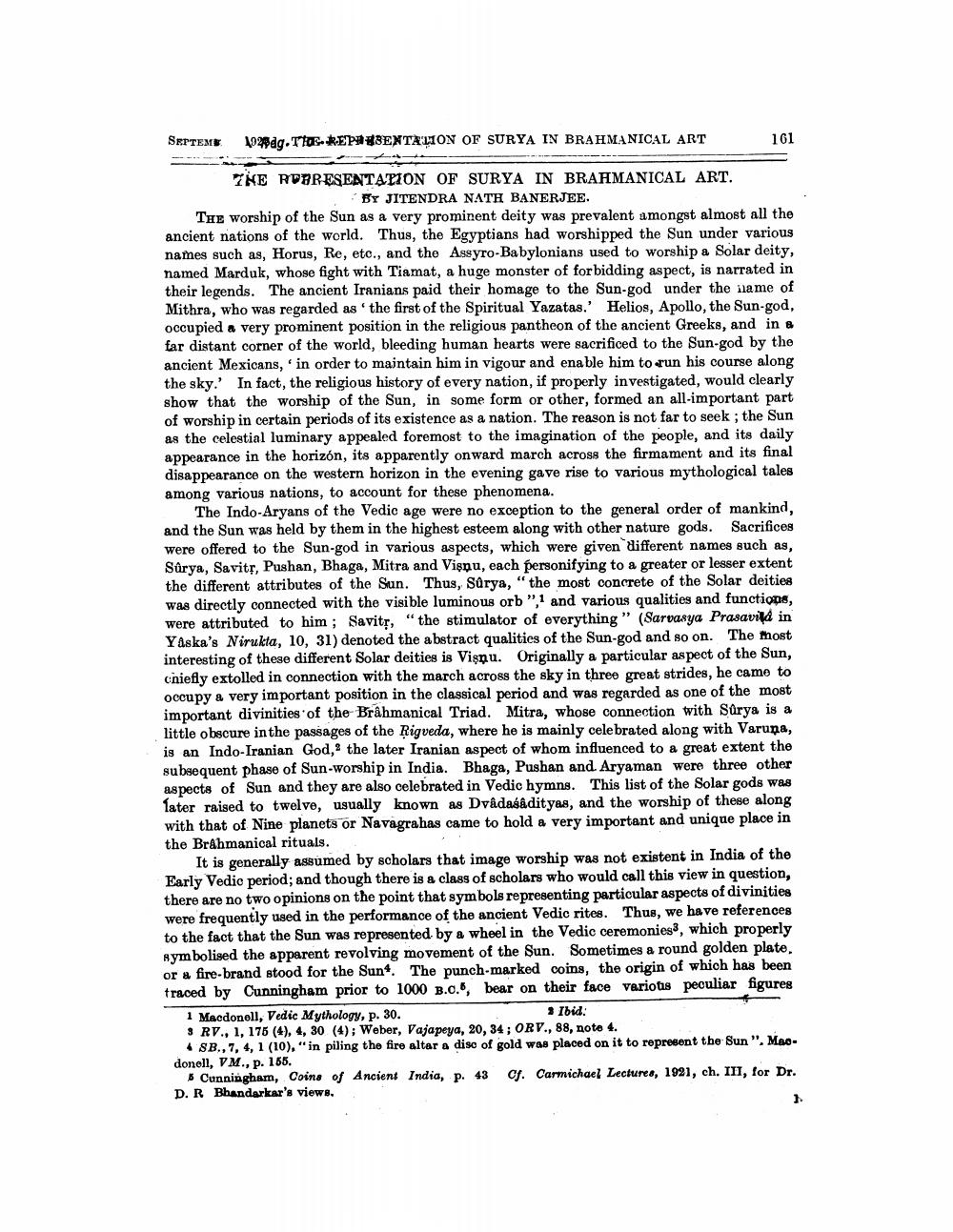________________
SETTEM
102dq.TE REPREBENTATION OF SURYA IN BRAHMANICAL ART
161
ZME RURRESENTATION OF SURYA IN BRAHMANICAL ART.
BY JITENDRA NATH BANERJEE. The worship of the Sun as a very prominent deity was prevalent amongst almost all the ancient nations of the world. Thus, the Egyptians had worshipped the Sun under various names such as, Horus, Re, etc., and the Assyro-Babylonians used to worship a Solar deity, named Marduk, whose fight with Tiamat, a huge monster of forbidding aspect, is narrated in their legends. The ancient Iranians paid their homage to the Sun-god under the name of Mithra, who was regarded as the first of the Spiritual Yazatas.' Helios, Apollo, the Sun-god, occupied a very prominent position in the religious pantheon of the ancient Greeks, and in a far distant corner of the world, bleeding human hearts were sacrificed to the Sun.god by the ancient Mexicans, in order to maintain him in vigour and enable him to run his course along the sky.' In fact, the religious history of every nation, if properly investigated, would clearly show that the worship of the Sun, in some form or other, formed an all-important part of worship in certain periods of its existence as a nation. The reason is not far to seek ; the Sun as the celestial luminary appealed foremost to the imagination of the people, and its daily appearance in the horizon, its apparently onward march across the firmament and its final disappearance on the western horizon in the evening gave rise to various mythological tales among various nations, to account for these phenomena.
The Indo-Aryans of the Vedic age were no exception to the general order of mankind, and the Sun was held by them in the highest esteem along with other nature gods. Sacrifices were offered to the Sun-god in various aspects, which were given different names such as, Sûrya, Savits, Pushan, Bhaga, Mitra and Vişnu, each personifying to a greater or lesser extent the different attributes of the Sun. Thus, Surya, “the most concrete of the Solar deities was directly connected with the visible luminous orb "1 and various qualities and functions, were attributed to him ; Savitr, "the stimulator of everything" (Sarvasya Prasavild in Yaska's Nirukta, 10, 31) denoted the abstract qualities of the Sun-god and so on. The most interesting of these different Solar deities is Vişņu. Originally a particular aspect of the Sun, chiefly extolled in connection with the march across the sky in three great strides, he came to occupy a very important position in the classical period and was regarded as one of the most important divinities of the Brahmanical Triad. Mitra, whose connection with Surya is a little obscure in the passages of the Rigveda, where he is mainly celebrated along with Varuna, is an Indo-Iranian God, the later Iranian aspect of whom influenced to a great extent the subsequent phase of Sun-worship in India. Bhaga, Pushan and Aryaman were three other aspects of Sun and they are also celebrated in Vedic hymns. This list of the Solar gods was later raised to twelve, usually known as Dvadasadityas, and the worship of these along with that of Nine planets or Navagrahas came to hold a very important and unique place in the Brahmanical rituals.
It is generally assumed by scholars that image worship was not existent in India of the Early Vedic period; and though there is a class of scholars who would call this view in question, there are no two opinions on the point that symbols representing particular aspects of divinities were frequently used in the performance of the ancient Vedic rites. Thus, we have references to the fact that the Sun was represented by a wheel in the Vedic ceremonies, which properly symbolised the apparent revolving movement of the Sun. Sometimes a round golden plate. or a fire-brand stood for the Sun*. The punch-marked coins, the origin of which has been traced by Cunningham prior to 1000 B.C., bear on their face various peculiar figures 1 Macdonell, Vedic Mythology, p. 30.
Ibid. 3 RV., 1, 176 (4), 4, 30 (4); Weber, Vajapeya, 20, 34; ORV., 88, note 4.
4 SB., 7, 4, 1 (10), "in piling the fire altar a dise of gold was placed on it to represent the Sun ". Maodonell, VM., p. 155.
Cunningham, Coins of Ancient India, p. 43 cf. Carmichael Lectures, 1921, ch. III, for Dr. D. R Bhandarkar's views.




